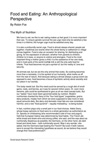Food and Eating: An Anthropological Perspective
– By Robin Fox
Food as Seduction
Feeding has always been closely linked with courtship. In nature this is not without its dangers. In several species of insect (the praying mantis, for example) the female devours the male after mating: he has done his job and so becomes a source of nutrition for the now expectant mother. Many species tone this down by having the male offer little packages of food to the female, who eats them and leaves him alone. The males and females of all species, including our own, seem to be involved in this mating gamble with food as the bait. Even if the male is not himself the food, he universally seems to have to make some show of feeding to be acceptable. With humans this works two ways since we are the only animals who cook: the bride is usually appraised for her cooking ability. ("Can she bake a cherry pie, Billy boy, Billy boy?") In some cultures this is far more important than her virginity.
But food and sex are generally closely linked. They are physically linked in the limbic system of the brain, which controls emotional activity generally. It is not surprising that we not only link them but do so emotionally. Good food = good sex. It is this sensuality of eating that spurs the puritan and ascetic rejection of food pleasures. But the link makes sense. To reproduce effectively, a female needs not only insemination but also provisioning. Particularly in species such as ours, where she is relatively dependent during the suckling period, she needs a male to provide food. Thus, a male’s willingness to provide food becomes an important index of his suitability as a mate. Above all, it suggests his willingness to "invest" in the female’s offspring. Studies of mate preferences in many cultures reveal that while men universally go for looks (actually a fair indicator of fertility), women go for provisioning: a male with resources is preferred to one without, regardless of his attractivity. Studies of Western females show that one of the most "attractive" features of a male is his willingness to "pick up the tab" for a meal. This may be an appeal to deep and atavistic survival motives in the female, but unscrupulous seducers can use it to their advantage. Courtship etiquette today seems to demand the offer of a meal by the male as part of foreplay; and the female is then supposed to cook breakfast to complete her part of the bargain. (Some modern cynic defined a contemporary "moral dilemma" as whether or not to go to bed with a man after only a cheeseburger.)
The choice of setting for food and courtship is as important as the food itself. There is a tendency to move gradually (or swiftly as the case may be) from the public to the private. For modern urban couples, "dates" usually begin in a crowded public place such as a bar or disco. On the crucial "second date," they may move to a restaurant, where the male is able to demonstrate his "resource accrual ability" by paying the bill This stage may be prolonged, but at some time the "your place or mine" issue will arise, with, researchers have found, her place being generally preferred. At this stage she is supposed to supply a meal - usually a "romantic" candlelight dinner - thus demonstrating her abilities as a cook and hostess. Breakfast follows the consummation, again usually cooked by the female since it’s her kitchen. But it is in order at this point for the male at least to offer to make breakfast, thus demonstrating his egalitarian and cooperative nature. If the relationship gets serious, then the next important ceremonial meal is likely to be with her family. Again the meal is used as a "bridge" to mark the importance of the event and as an icebreaker and demonstration of the family’s good will. The prospective mate joins her family at its most familial: eating the family meal. He can be scrutinized in this setting; his manners, speech, and behavior can be assessed. He in turn gets to see his prospective in-laws close up, in a setting which both offers information and lubricates the difficult mechanism of social interaction. Sex and eating have perhaps never been so brilliantly brought together as in the film Tom Jones, where the marvelously sensual meal becomes both a prelude to, and an analogue of, intercourse. The Romantic Dinner is the form of therapy most recommended for jaded couples. Again the equation of good food, good sex, and emotional security taps very deep motives lodged in the basic mammalian search for reproductive success.


